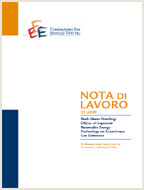Nuclear versus Coal plus CCS: A Comparison of Two Competitive Base-load Climate Control Options

01.09.2009
Massimo Tavoni, Bob van der Zwaan
D8, D9, H0, O3, O4, Q4, Q5
Economic Competition, Electricity Sector, Nuclear Power, Coal Power, CCS, Renewables, Climate Policy
Climate Change and Sustainable Development
Carlo Carraro
In this paper we analyze the relative importance and mutual behavior of two competing base-load electricity generation options that each are capable of contributing significantly to the abatement of global CO2 emissions: nuclear energy and coal-based power production complemented with CO2 capture and storage (CCS). We also investigate how, in scenarios from an integrated assessment model that simulates the economics of a climate-constrained world, the prospects for nuclear energy would change if exogenous limitations on the spread of nuclear technology were relaxed. Using the climate change economics model WITCH we find that until 2050 the resulting growth rates of nuclear electricity generation capacity become comparable to historical rates observed during the 1980s. Given that nuclear energy continues to face serious challenges and contention, we inspect how extensive the improvements of coal-based power equipped with CCS technology would need to be if our model is to significantly scale down the construction of new nuclear power plants.
***
Suggested citation: Tavoni, Massimo and van der Zwaan Bob, Nuclear Versus Coal plus CCS: a Comparison of Two Competitive Base-Load Climate Control Options, Environmental Modeling & Assessment, October 2011, Volume 16, Issue 5, pp 431-440, http://rd.springer.com/article/10.1007%2Fs10666-011-9259-1
